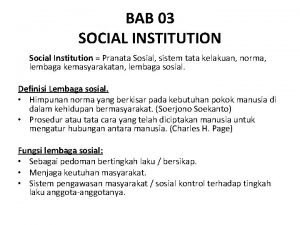A Financial Institution is an institution that provides





















- Slides: 21


A Financial Institution is an institution that provides financial services for its clients or members. Probably the most important financial service provided by financial institutions is acting as financial intermidiaries. Most financial institutions are highly regulated by government.

CONTD. Broadly speaking, there are 3 major types of financial institutions: 1. Deposit-taking instuitions that accept and manage deposits and make loans, including banks, building societies, credit unions, trust companies, and mortgage loan companies 2. Insurance companies and pension funds 3. Brokers, underwriters and investment funds

The financial institutions in India are divided in 2 categories. 1. Regulatory instituitions 2. Intermidiaries

The regulators are assigned with the job of governing all the divisions of the Indian financial system. These regulatory institutions are responsible for maintaining the transparency and the national interest in the operations of the institutions under their supervision.

� Reserve Bank of India (RBI) � Securities Exchange Board of India (SEBI) � Central Board of Direct Taxes (CBDT) � Central Board of Excise and Customs

Apart from the regulatory bodies, there are the intermediaries that include the banking and non-banking financial institutions. Some of the specialised financial institutions in India are as follows: � Unit Trust of India (UTI) � Securities Trading Corporation of India Ltd. (STCI) � Industrial Develpoment Bank of India (IDBI)

� Industrial Reconstruction Bank of India (IRBI), now Industrial Investment Bank of India � Export – Import Bank of India (EXIM Bank) � Small Industries Develpoment Bank of India (SIDBI) � National Bank for Agriculture and Rural Development (NABARD) � Life Insurance Corporation of India (LIC) � General Insurance Corporation of India (GIC) � Shipping Credit and Investment Company of India Ltd. (SCICI) � Housing and Urban Development Corporation Ltd. (HUDCO) � National Housing Bank (NHB)

Contd. The banking institutions of India play a major role in the economy of the country. The banking institutions are the providers of depository and transaction services. These activities are the major sources of creating money. The banking institutions are the major sources of providing loans and other credit facilities to the clients. Apart from the banking financial institutions, there a number of specialised financial instutitions in India that have been incorporated for a definite purpose.

Contd. These institutions include the insurance companies, the housing finance companies, mutual funds, merchant banks, crediat reporting and debt collection companies and many more. Apart from these, there are several other financial institutions that are existing in the country. These are the stock brokers, portfolio managers, investment advisors, underwriters, foreign institutional investors and many more.

� Divorce between saving and investment � Three kinds of economic units i. Saving Surplus Unit ii. Economic Unit or Saving Deficit Units iii. Neutral Units � For capital formation - savings of first group must be transferred to second group � Financial institutions help in this transfer process

1. Creation of savings 2. Mobilization of savings 3. Investment of savings

Savings are done by individuals or households. They save by not spending all their income on consumer goods. When the individuals or housholds save they release resources from the production of consumer goods. Workers, natural resources, materials etc. thus released are made available for the production of capital goods.

Savings of the households must be mobilized and transferred to businessmen or entrepreneurs who require them for investment.

� Financial institutions play a significant role in capital formation � Capital Formation critical and indispensable for economic develpoment � The process of capital formation involves: Savings Credit Investments

� Contd. �The volume of capital formation depends on intensity & efficiency with which the above 3 activities carried out. �Financial Institutions plays an important role in efficient allocation of funds from saving surplus to saving deficit units through various financial innovations and developments in technology. �Financial Institutions act as a link between the saver and investor.

Seeking of funds (mainly business and government) Flow of funds (savings) Flow of financial services Income and Financial claims Suppliers of funds (mainly housholds)

i. iii. The transfer of savings from households and government to the business sector has increased output and economic development. The creation of productive assets that expand an economy’s capacity to produce goods and services. Private savings facilitates capital formation by allowing resources to be diverted to corporate investment rather than individual consumption. In the capital market, funds are supplied by the individual investors (who may buy securities or shares issued by companies), banks, investment trusts, insurance companies, finance companies, governments etc.

� For savings to result in capital formation, they must be invested. In order that the investment of savings should take place, there must be a good number of honest and dynamic entrepreneurs in the country who are able to take risks and bear uncertainty of production. � Investment will be made by the entrepreneurs only if there is sufficient inducement to invest. Inducement to invest depends on the marginal efficiency of capital (i. e. the prospective rate of profit )& rate of interest.

To create more capital in the market reserve bank follows the policy of deficit financing � Deficit financing i. e. newly created money is another source of capital formation. By issuing more notes and exchanging them with the productive resources, the government can build real capital. � The method of deficit financing as a source of development finance is dangerous because it often leads to inflationary pressures in the economy.

 Formal institution and informal institution
Formal institution and informal institution Con hãy đưa tay khi thấy người vấp ngã
Con hãy đưa tay khi thấy người vấp ngã Thơ thất ngôn tứ tuyệt đường luật
Thơ thất ngôn tứ tuyệt đường luật Tôn thất thuyết là ai
Tôn thất thuyết là ai Phân độ lown ngoại tâm thu
Phân độ lown ngoại tâm thu Chiến lược kinh doanh quốc tế của walmart
Chiến lược kinh doanh quốc tế của walmart Gây tê cơ vuông thắt lưng
Gây tê cơ vuông thắt lưng Block xoang nhĩ độ 2 type 1
Block xoang nhĩ độ 2 type 1 Tìm vết của mặt phẳng
Tìm vết của mặt phẳng Sau thất bại ở hồ điển triệt
Sau thất bại ở hồ điển triệt Thể thơ truyền thống
Thể thơ truyền thống Financial method of motivation
Financial method of motivation General reaction of amino acid metabolism slideshare
General reaction of amino acid metabolism slideshare Ir spectroscopy provides information about
Ir spectroscopy provides information about It provides structural support for the entire body
It provides structural support for the entire body Electrical potential energy
Electrical potential energy Provides practically all the energy for ecosystems
Provides practically all the energy for ecosystems Who is the thane of glamis?
Who is the thane of glamis? Transistor stabilization
Transistor stabilization Cdpd provides low cost wireless data services to
Cdpd provides low cost wireless data services to Provides the body with energy. *
Provides the body with energy. * Leads database law enforcement
Leads database law enforcement









































